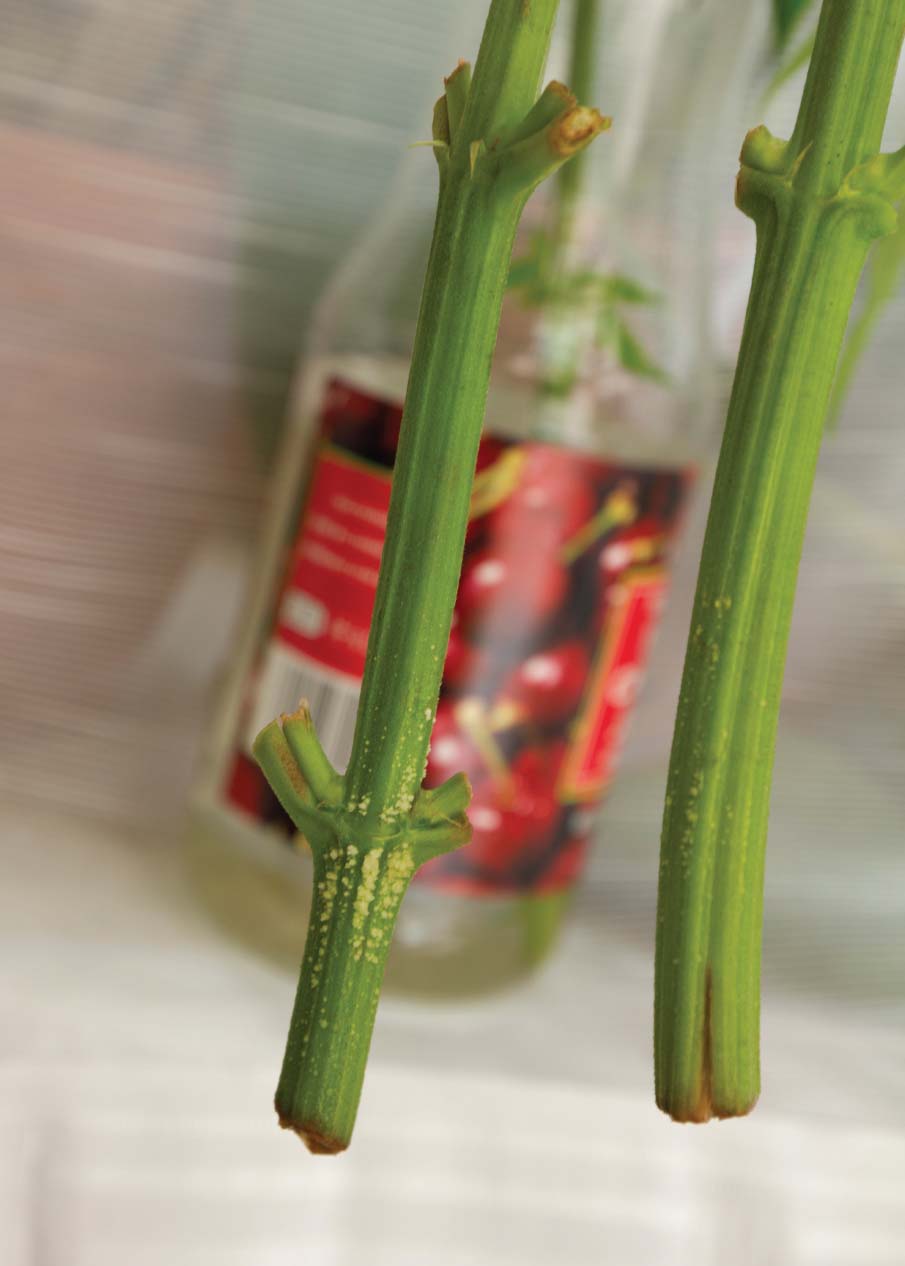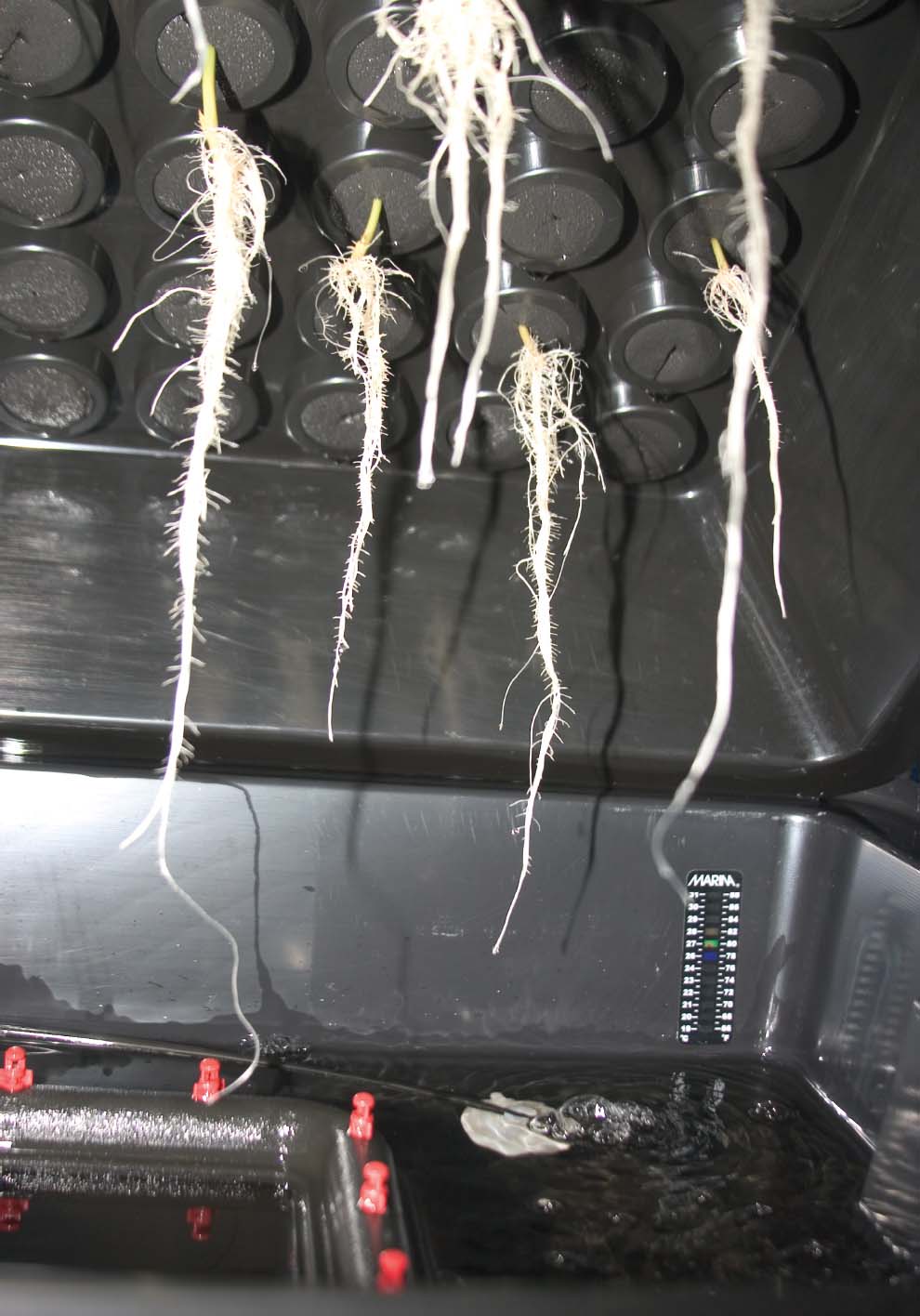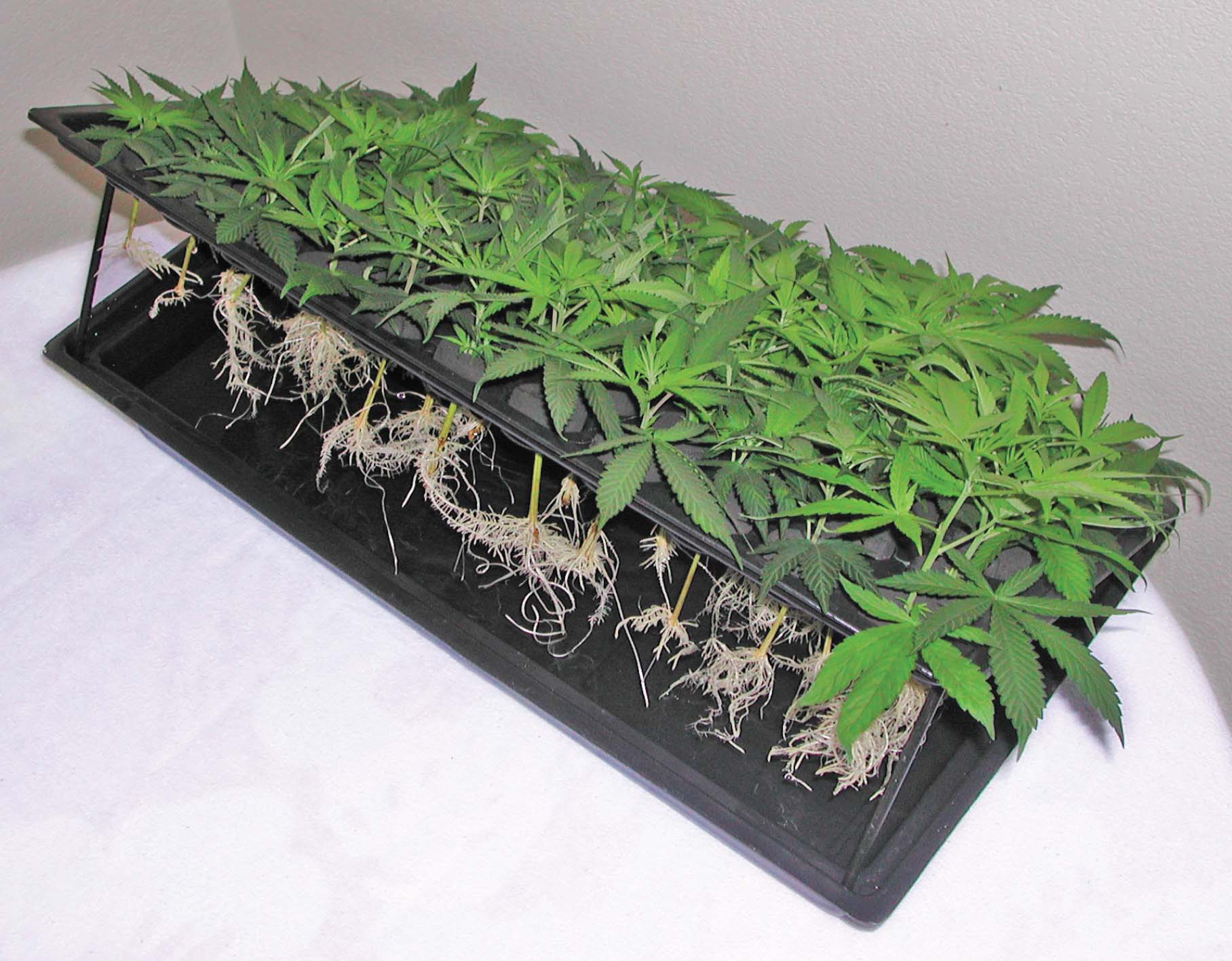
APPENDIX A: CLONING
Plant cells have a property called totipotency; any plant cell can dedifferentiate and redifferentiate into any other type of tissue. In other words, an epidermal cell can turn into a root cell, and that is exactly what happens when a cultivator takes a cutting to clone a plant. This is an example of asexual or vegetative reproduction. Since the cutting has the same genetics as the “mother” plant from which it was taken, it will have the same characteristics.
Using clones has several advantages over using seeds.
- Clones are faster and easier to start than germinating seeds.
- Seeds require sexing. Clones are the same sex as the plant from which they are cut.
- Plants grown from seeds of the same variety can vary in quality. Clones are uniform.
- Clones have been selected for high quality.
A potential disadvantage of using clones rather than seeds is that they may not grow as vigorously, especially outdoors. Unlike seeds, clones do not have a taproot.
Plant roots need oxygen. That’s why the cutting’s planting medium is selected for its ability to provide oxygen to the root zone. When cuttings receive abundant amounts of oxygen in the water or planting medium, they form a larger root mass, capable of taking up more water and nutrients, resulting in faster growth and healthier plants.
Cuttings are best made while the plant is still in its vegetative growth stage. However, they can be taken even as the plant is being harvested. Cuttings generally root within one to two weeks when they are given a clean, humid, moist, and warm environment.
Cuttings do not have any roots, so they have a limited ability to absorb water. Keep the humidity between 75 and 85%, so they aren’t placed under stress.
Cuttings root fastest when they are kept at about 75-80°F (24-7°C). It is important that both the air and the rooting area are kept warm. At lower temperatures the clones root slower.
At first, use a moderate amount of light, between 100-200 µmol·m-2·s-1. (See Light.) A 4-foot (122 cm) long rack holds four 10 × 20 inch (25 × 50 cm) trays. High-output T5 fluorescents can provide enough light until the cuttings start to root; however, this is old technology, and fluorescents in older fixtures can be replaced with LED arrays. With new dedicated LED fixtures, there is the added benefit of light intensity control. After cuttings have rooted, they require twice the light, which can be supplied by adjusting the LED’s brightness.
Cuttings can be rooted in coir, vermiculite, perlite, peat moss, Excel plugs, rockwool, soil, commercially available rooting plugs, and other porous rooting materials.
Most professional cloners prefer rockwool, which promotes very fast rooting. Most cloning machines use aeroponics or water sprays. Other cloning machines hold the cuttings in place while the stems soak in aerated water, which adds the benefit of a highly oxygenated environment ideal for new root production.
Rooting hormones are compounds used to promote root initiation. These hormones mimic the activity of the plant’s natural auxins. Auxins will promote the dedifferentiation and then redifferentiation of plant cells into root tissue.
Cloning: Step-by-Step
Equipment
- Scissors: use sharp, sanitized, and comfortable scissors. Spring-loaded scissors are easy on the muscles because they do not have to be pulled back to open position.
- Clean, well-lit work area.
- Small jars or glasses filled with water to hold the cuttings before they are prepared for planting.
- Alcohol, hydrogen peroxide, bleach, hypochlorous acid, or another disinfectant in a spray bottle and cloth or paper towels for sterilization.
- Root dip solution. Most rooting hormones contain naphthalene acetic acid (NAA), indole-3 acetic acid (IAA), indole-butyric acid (IBA), or a combination of these three root stimulators. Many brands are available.
- Containers with sterile medium, or cubes that are ready for clones. If using rockwool that has not been pre-washed of lime, soak it in water pH adjusted to 5.5 for 24 hours. This removes the lime.
- Lighted shelf.
- Trays, humidity domes, heat mats, and thermostat.

These plant tops were placed in water five days earlier and are now showing budding roots. Water was changed daily. Photo: Ed Rosenthal

These clones were started in Excel cubes and have been transferred to LECA clay pellets. They will be transferred to a larger hydroponics system soon. Photo: Ed Rosenthal
Directions
- Wipe down the work space and scissors with hydrogen peroxide, bleach, hypochlorous acid, or another disinfectant to sterilize.
- Wash hands and put on a pair of sanitary gloves.
- From the mother plant, take cuttings about 4-6 inches (10-15 cm) in length, and place the cut ends in a glass of water to prevent dehydration. See the additional trimming instructions following this section in order to choose where to cut the clone.
- Trim the cuttings. Place them in a second glass of water until they are ready to be placed.
- Line the clones up by the leaf canopy and then cut the stems so that the clones are the same length.
- Wipe the scissors with sterilizer and then cut the stems an eighth of an inch (3 mm) from the end.
- Dip the cuttings in the rooting solution to about half an inch (13 mm).
- Place the clones at least 1 inch (25 mm) deep in the medium.
- Irrigate using water adjusted to a pH of 5.8-6. They need no enhancers or nutrients for the first few days.
- Various rooting enhancers are available. They contain plant hormones and nutrients and are added to the water solution.
- Compost tea or mycorrhizae-beneficial bacteria mixes can also be added once roots have begun to grow into the medium. The mycorrhizae develop symbiotic relationships with the roots.
- Spray the top of the medium with hydrogen peroxide as an antiseptic.

The misters (red) constantly spray very fine oxygenated water at the cuttings. Photo: Ed Rosenthal
Trimming the Clone
The strongest clones are cut from the new growth at the ends of the branches. These cuttings are four to six inches (10-16 cm) long. A cut is made with a sterile blade at a 45° angle in order to create more surface area on the stem to pull water into the cutting. Remove the large leaves and vegetative growth except for three medium-size leaves surrounding the growing tip. At the end of the trimming, only one to two inches (2.5 to 5 cm) of leaf should remain at the top of each cutting. The rest of the stem is bare. Care should be taken that at least one removed node, where a leaf’s petiole was attached, is near the base of the stem, ensuring that it will be inserted into the rooting medium. Cuttings with nodes in the medium root faster than those with nodeless stems. Roots emerge from the node site faster than along the stem’s internode. Trim back the laminae, or blades of the leaf, to reduce the amount of leaf material. This will help the plant retain water as it eliminates stomata, pores in the leaf where water vapor is released. Leave at least 1 to 2 inches (2.5-5 cm) of leaf surface. Try to get all the cuttings to be about the same length. The uniformity will mean that longer cuts don’t shade neighbors and thus slow the rooting process.
Clone preparation techniques vary. Larger or smaller clones can be taken. Both have advantages. Larger clones require less time in the vegetative stage. Smaller clones allow the grower to produce more cuttings from a mother plant and to produce more of them in a small space.
If large numbers of cuttings are being taken, a system using multiple stem cuttings from one branch can be used. Cuttings can be made from many of the internodes along the branch, which have vegetative growth. These cuttings are at least four inches (10 cm) long and have some leaf material and a node to plant.
If a technique works well for the grower, and the grower is satisfied with the results, then it is the right way.
Rooting in Water
Cannabis cuttings can be rooted in room temperature water. Using tap water is fine but change the water every day to make sure it has enough oxygen. Shake the water before using it to oxygenate it. Several commercial units use oxygenated water as a rooting medium.
Another technique uses a piece of Styrofoam board with holes punched to hold the clones. The board floats in a tray with water heated and aerated using an air pump and a bubbler. When the cuttings begin to root, they are moved to a solid planting medium. Aerating and heating the water to 72°F (22°C) speeds up the rooting process.
Aeroponic Rooting
Most cloning machines use aeroponics for rooting. The plant canopy is held above the reservoir while the stems hang down in a chamber or are held in a mesh cup. Misters emit fine sprays that bathe the stem in highly oxygenated water. Clone machines promote very fast rooting because they provide an excellent balance of water, oxygen, and root zone temperature.
Aeroponic and water culture cuttings do not require as high humidity as those rooted into planting mediums. They can be kept at 50-60% humidity. Aeroponic and water culture systems get the cuttings past the most difficult phase, the first few days after being cut. Transfer them to other mediums as soon as roots appear.
One popular commercial cloning kit consists of a tray that holds peat pellets in a miniature greenhouse. The cuttings are placed one to a peat pellet. Fairly small-to-large-size cuttings can be placed in these pellets. Peat pellets are especially convenient for rooting plants that will be placed in indoor or outdoor soil mixes.

Cuttings in a commercial water cloner produce vigorous roots quickly as long as water oxygen levels are maintained. Photo: Ed Rosenthal
Maintaining Temperature & Humidity
In gardens where only a few clones or a few trays of clones are being propagated, high humidity and temperature can be maintained using horticultural heat mats, or a heated propagation tray with a high dome. Heating clones helps promote plant respiration. Plants not only absorb water and nutrients through their roots but also respire, and the rate of respiration is directly related to the plant’s temperature.
Maintaining high temperature and humidity in a small room or even a closet-size space takes some effort. The lighting helps raise temperature, and humidifiers keep the humidity high. CO2 generators burn propane or natural gas. They also produce heat and humidity. Use a thermostat to regulate the generator. Even with the added moisture, the room is likely to have humidity of less than 80%. Use a humidifier regulated by a humidistat. Five-micron misters are an efficient alternative. Once installed, they require little maintenance and are inexpensive to operate.